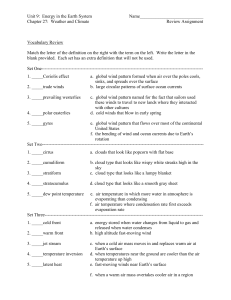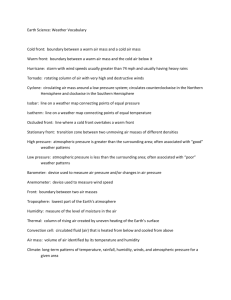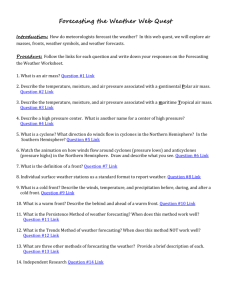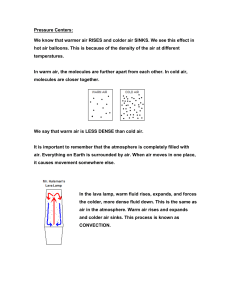Winds. Climate. Hydrosphere. - Department of Physics and Astronomy
advertisement
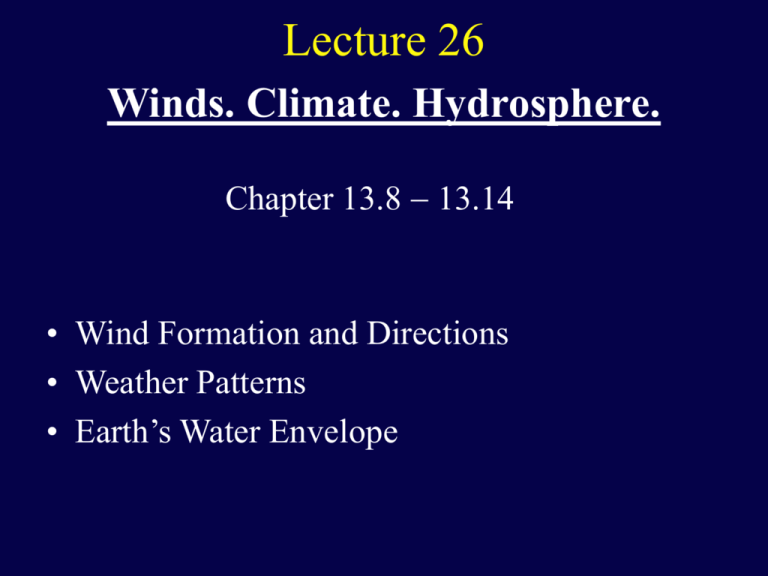
Lecture 26 Winds. Climate. Hydrosphere. Chapter 13.8 13.14 • Wind Formation and Directions • Weather Patterns • Earth’s Water Envelope Winds Winds are horizontal movements of air caused by pressure differences in the atmosphere. The pressure differences are due to temperature differences. The higher the differences, the stronger the winds. This type of air movements is called convection currents. Another type of air movements are due to the Coriolis effect. It is due to Earth rotation and makes wind paths curved. Circulation in the Atmosphere The air is heated near the equator, rises and flows toward the poles, where it cools down and returns back as winds. Due to rotation, the north and south wind are deflected by the Coriolis effect. This leads to westward drift in the middle of each hemisphere and a eastward drift in the tropics. The westward winds contain zones of high-speed winds called jet streams (up to 500 km/h). Weather Systems Weather is changes of the atmospheric parameters: temperature, humidity, air pressure, cloudiness, rainfall. The most variable weather occurs in the middle latitudes. This is due to movements of warm and cold air masses through the belts of western winds (westerlies). Air masses are large, isolated, moving bodies of air. Weather systems associated with air masses are hundreds to a thousand kilometers across. There are 2 distinct types of weather systems depending on air pressure in their centers: cyclones and anticyclones. Cyclones A cyclone is an air mass in which the pressure is low at the center. Air moves toward the center and is deflected by the Coriolis effect: to the right in the Northern hemisphere). Cyclonic winds blow in a counterclockwise spiral (Northern hemisphere). The situation reverses in the Southern hemisphere. Warm air rises, cools down, and moisture condenses in it. Cyclones bring unstable weather with rain (snow) and abrupt temperature changes. Tropical cyclones are named to ease communication between forecasters and general public. Anticyclones An anticyclone is centered on a high-pressure region from which air moves outward. Due to Coriolis effect, winds in an anticyclone blow clockwise in the Northern hemisphere. The air descents, warms, becomes less saturated with moisture, and brings good weather with clear skies. Fronts Fronts are boundaries between different air masses. When warm air enters a cold air mass, a low-pressure region is produced and it moves as a cyclone. In middle northern latitudes, such a cyclone usually moves eastward. The eastern side of the warm air region is a warm front, while the eastern side is a cold front (because cold air replaces warm air). Warm air rises, cools, and produces clouds. A warm front typically moves at ~150 km/day. A cold front moves faster, overtakes the warm front, forces warm air upward, and ceases the cyclone (occluded front). Climate Climate is a summary of the weather in a region. The most significant weather elements are temperature and precipitation. Tropical climates. Near the equator, the insolation is the highest, a lot of evaporation and rains. At horse latitudes (~30O S & N), winds are calm, air moves downward, less moisture, drier weather. Mid-latitude climates. Moderate average temperatures with great variations between seasons. Northern hemisphere: Air from the Pacific rises up above the mountains, rain on the western side, drier on the eastern. Climatic Changes Daily, seasonal, and yearly weather changes are due to variations, sometimes not well understood, in the atmospheric physical parameters. Climatic changes are rare (for example, ice ages). Little ice age 16451715 due to lower solar activity. Ice age ~1800 years ago due to ~4 km ice sheets covering both Europe and North America. Warming since the end of the 19th century. Origin: periodic changes in the tilt of the Earth’s rotation axis. The basic reason is thought to be insolation of polar regions (Milankovitch hypothesis). Hydrosphere ~70% of the Earth’s surface is covered by oceans and connected seas, which are full of life. Surface water evaporates and influences weather. Water absorbs solar energy and distributes it around the world. Oceans are large basins bounded by continents. An ocean bottom gradually slopes down to ~130m with an average width of 65 km (varying from 1 to 1000 km). This continental shelf turns into continental slope (down to ~2 km), which joins the abyssal plain via continental rise. Oceans average depth is ~3.7 km. Marianas Trenches – 11 km below the surface. Ocean Currents Two ways oceans affect climate: • Store heat (the first few meters contain more heat than the entire atmosphere). • Surface currents, produced by friction of air and water. Heat transfer between air and water can exceed the rate of arriving solar energy at the Earth. This is why continents are cooler in winters than coastal regions and islands. Surface currents are wind-driven and mostly parallel to major wind streams and form equatorial current. This current runs into South America in the Atlantics and into the East Indies in the Pacific. Ocean Currents At each of the contacts the current divides into 2 parts. One flows to the south, the other one to the north. Then westerlies drive them eastward across the oceans. This mechanism produces 4 large whirlpools. The Gulf Stream Gulf Stream is a warm current moving partly into the Gulf of Mexico, partly straight north along the US eastern coast. It splits on the European side: one part moves south and completes the whirl, the other one moves into the Arctic Ocean. Gulf Stream makes climate of NW Europe milder. Summary Earth’s atmosphere was developed over a large period of time and is hospitable for life due to the right distance from the Sun. Weather is mostly due to the large amount of vaporized water and winds, which exist due to the planet rotation and uneven distribution of continents and oceans. Water in oceans generally follows the wind directions and is affected by the current distribution of continents.

